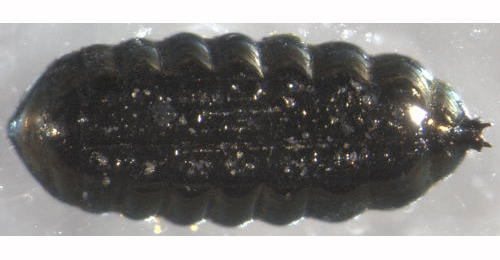|
||||||
| Cerodontha lateralis (Macquart, 1835) [Diptera: Agromyzidae] |
||||||||||||||||||||||||||||||||||||||||||||||||||||||||||||||||||||||||||||||||||||||||||||||||||||||||||||||||||||||||||||||
|
Agromyza
lateralis Macquart, 1835. Hist. nat. Ins., Dipt. 2:
609 |
||||||||||||||||||||||||||||||||||||||||||||||||||||||||||||||||||||||||||||||||||||||||||||||||||||||||||||||||||||||||||||||
|
Leaf-miner: A linear mine running towards the apex of the leaf and this can widen and become almost blotch-like. Pupation internal (Spencer, 1976: 194, 195 (fig. 340). Upper surface corridor, mostly in the lower half of the blade, running upwards, and never occuping more than half the width of the leaf. Larva solitary. Frass in green smears. Pupation inside the mine (Bladmineerders van Europa). Larva: The larvae of flies are leg-less maggots without a head capsule (see examples). They never have thoracic or abdominal legs. They do not have chewing mouthparts, although they do have a characteristic cephalo-pharyngeal skeleton (see examples), usually visible internally through the body wall. The larva is described by Nowakowski (1973) and Venturi (1935). The two rear arms of the cephalic skeleton dark form most of their length. Posterior spiracles laterally with a black, finely spinulose wart, wich is not so large that it covers the tracheal tube behind it (Bladmineerders van Europa). Puparium: The puparia of flies are formed within the hardened last larval skin or puparium and as a result sheaths enclosing head appendages, wings and legs are not visible externally (see examples). Brownish-black (Spencer, 1976: 194). Illustrated in Bladmineerders van Europa.
Hosts in Great Britain and Ireland:
Hosts elsewhere:
Time of year - mines: June-September (Bladmineerders van Europa). Time of year - adults: May. Distribution in Great Britain and Ireland: Uncommon in England including Huntingdonshire (Woodwalton Fen), Suffolk (Barton Mills) (Spencer, 1972b: 102), Warwickshire (Binley, Corley and Exhall) (Robbins, 1991: 136); Cambridgeshire, East Kent, East Suffolk, Huntingdonshire, North Somerset, South Essex, South-west Yorkshire and West Gloucestershire (NBN Atlas). Distribution elsewhere: Widespread in continental Europe (Spencer, 1972b: 102) including Denmark, Finland, the [former] U.S.S.R. (Spencer, 1976: 194), The Netherlands (Bladmineerders van Europa), Belgium (Scheirs, de Bruyn and von Tschirnhaus, 1996), Germany (Spencer, 1976: 554), Czech Republic, European Turkey, French mainland, Hungary, Lithuania, Poland, Slovakia, Spanish mainland and Yugoslavia (Fauna Europaea). Also recorded in Japan (Spencer, 1976: 194) and Canada (Spencer, 1969a: 131). NBN Atlas links to known host species:
British and Irish Parasitoids in Britain and elsewhere:
|
|
|
|
| External links: | Search the internet: |
| Biodiversity Heritage Library Bladmineerders van Europa British leafminers Encyclopedia of Life Fauna Europaea NBN Atlas NHM UK Checklist |
Find
using Google Find using Google Scholar Find images using Google |
| Last updated 09-Jul-2019 Brian Pitkin | ||

